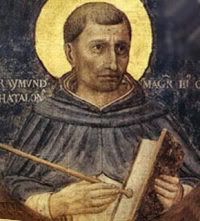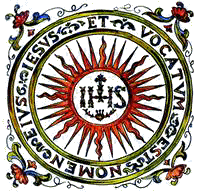
St. Raymond of Peñafort
Feast Day: January 7
1175-1275
Patron of Canon Lawyers
Like his contemporary, Saint Thomas Aquinas, Raymond was of noble descent; his was the illustrious family of Penafort, related to the kings of Aragon. He was born at Villafranca, near Barcelona, Spain, in 1175. As a boy he was a bright and able student; at twenty he was already a professor of philosophy. He taught in Barcelona for fifteen years, then went to Bologna, Italy, to study for his doctorate in civil and canon law. He received the degree in 1216, and three years later returned to Spain.
On Good Friday of the year 1222, Raymond entered the Dominican Order in Barcelona. As a novice he exhibited the same humility and spirit of mortification that in later life won him the respect and love of his king and the pope. It was during his novitiate that he prepared a collection of "cases of conscience" for the guidance of confessors and moralists. This work, entitled The Summa of Penitential Cases, was the first guide of this kind to be compiled.
Aside from his scholarly pursuits, Raymond preached with untiring zeal to the Jews and Moors (Arab invaders of Spain). He also acted as spiritual director for King James of Aragon and Saint Peter Nolasco, whom he aided in founding the Order of Our Lady of Mercy (Mercedarians) for the ransom of captives from the Moors.
King James valued Raymond so highly that on several occasions he sent him on missions to the Holy See. At one time, however, he stoutly resisted Raymond's admonitions regarding chastity, and a miracle was required before the monarch consented to reform his life. This miracle took place during a visit to Majorca on which Raymond had accompanied the king in the hope of strengthening Christianity there. They had been on the island only a short time when Raymond discovered that the king was involved in a sinful love affair with a woman of the court. The king refused to listen to Raymond's protests, and when Raymond threatened to leave the island, the king threatened with death anyone who would give him passage.
Thereupon, or so it is said, Raymond spread his cloak on the water, set up his staff as a mast, and, having rigged up a corner of the cloak as a sail, boarded this miraculous "boat," setting his course for Barcelona. He arrived there the same day, having covered 140 miles in about six hours. A great crowd assembled at the waterfront witnessed the end of this marvelous voyage, which inspired numerous conversions. Raymond's work in Spain was interrupted in 1230, when he was summoned to Rome by Pope Gregory IX, appointed to the papal court, and made papal confessor. He was then charged with the task of rearranging and codifying the canon laws of the Church. His success in this vast editorial job is astonishing, since he had to rewrite and condense decrees that had been accumulating for centuries. Completed in 1234., the work remained the most authoritative compilation within the body of canon law until 1917, when a new code was published. Gregory sought to reward Raymond by appointing him archbishop of Tarragona, but the saint declined the honor and returned to Spain.
In 1238 Raymond was elected general of the Dominican Order. This honor, too, was unsought and undesired, but he humbly obeyed the decision of his brothers, ruled them for two years, then resigned because of ill health. Although he was now an elderly man, Raymond had no intention of retiring. He was still vitally concerned with converting the Jews and the Moors, and so he contributed the alms he received from bishops and princes to schools where missionaries could be taught the Hebrew and Arabic languages. He also asked Saint Thomas Aquinas to write a book exposing the errors of the Mohammedan rationalists. Thomas complied by composing the Summa contra gentiles, one of his most famous works.
Raymond died on January 6, the Feast of the Epiphany, in 1275, the hundredth year of his life. He was canonized in 1601 by Pope Clement VIII.
Got it here.




















No comments:
Post a Comment